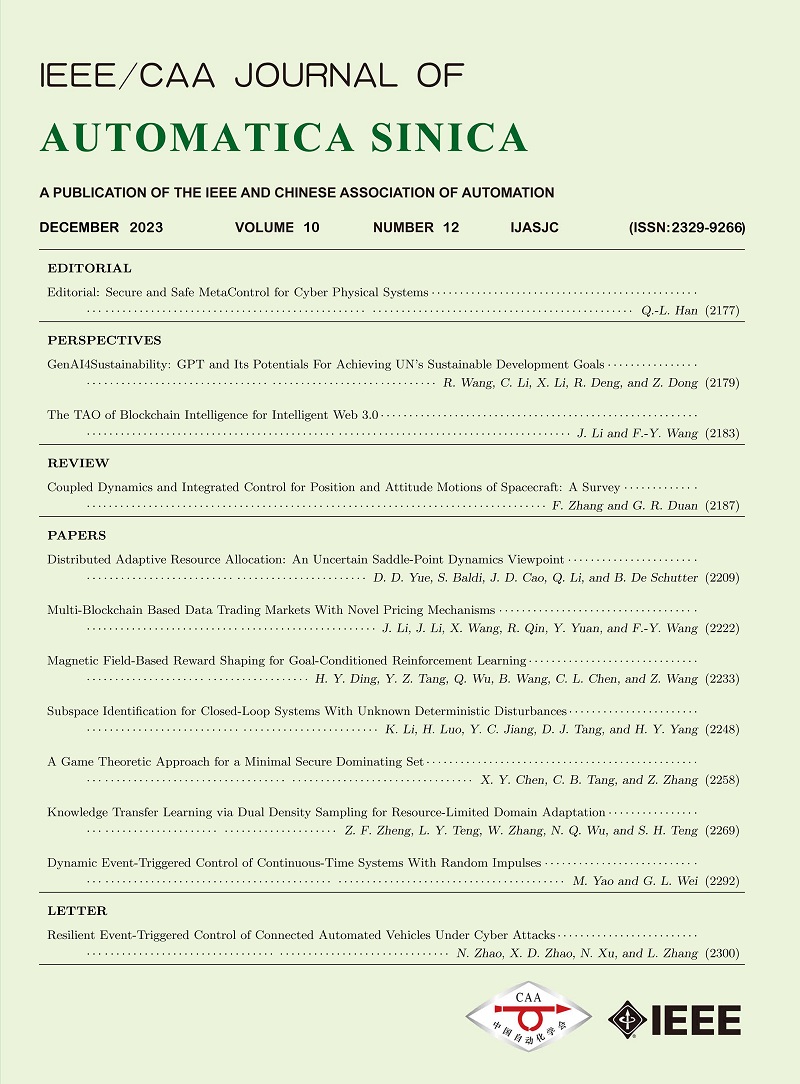 Volume 10
Issue 12
Volume 10
Issue 12
IEEE/CAA Journal of Automatica Sinica
| Citation: | R. Wang, C. Li, X. Li, R. Deng, and Z. Dong, “GenAI4Sustainability: GPT and its potentials for achieving UN’s sustainable development goals,” IEEE/CAA J. Autom. Sinica, vol. 10, no. 12, pp. 2179–2182, Dec. 2023. doi: 10.1109/JAS.2023.123999 |

| [1] |
J. D. Sachs, G. Schmidt-Traub, M. Mazzucato, D. Messner, N. Nakicenovic, and J. Rockström, “Six transformations to achieve the sustainable development goals,” Nature Sustainability, vol. 2, no. 9, pp. 805–814, 2019. doi: 10.1038/s41893-019-0352-9
|
| [2] |
I. A. Almuaqel, “Special needs, special efforts: Learners with intellectual disabilities and sustainable development goals (SDGs),” IEEE Trans. Engineering Management, pp. 1–18, 2022.
|
| [3] |
P. Anastas, M. Nolasco, F. Kerton, M. Kirchhoff, P. Licence, T. Pradeep, B. Subramaniam, and A. Moores, “The power of the united nations sustainable development goals in sustainable chemistry and engineering research,” ACS Sustainable Chemistry & Engineering, vol. 9, no. 24, pp. 8015–8017, 2021.
|
| [4] |
R. Vinuesa, H. Azizpour, I. Leite, M. Balaam, V. Dignum, S. Domisch, A. Felländer, S. D. Langhans, M. Tegmark, and F. Fuso Nerini, “The role of artificial intelligence in achieving the sustainable development goals,” Nature Communications, vol. 11, no. 1, pp. 1–10, 2020. doi: 10.1038/s41467-019-13993-7
|
| [5] |
F.-Y. Wang, J. Yang, X. Wang, J. Li, and Q.-L. Han, “Chat with ChatGPT on Industry 5.0: Learning and decision-making for intelligent industries,” IEEE/CAA J. Autom. Sinica, vol. 10, no. 4, pp. 831–834, 2023. doi: 10.1109/JAS.2023.123552
|
| [6] |
C. Stokel-Walker and R. Van Noorden, “What ChatGPT and generative AI mean for science,” Nature, vol. 614, no. 7947, pp. 214–216, 2023. doi: 10.1038/d41586-023-00340-6
|
| [7] |
T. Wu, S. He, J. Liu, S. Sun, K. Liu, Q.-L. Han, and Y. Tang, “A brief overview of ChatGPT: The history, status Quo and potential future development,” IEEE/CAA J. Autom. Sinica, vol. 10, no. 5, pp. 1122–1136, 2023. doi: 10.1109/JAS.2023.123618
|
| [8] |
Z. Epstein, A. Hertzmann, the Investigators of Human Creativity, M. Akten, H. Farid, J. Fjeld, M. R. Frank, M. Groh, L. Herman, N. Leach, R. Mahari, A. entland, O. Russakovsky, H. Schroeder, and A. Smith, “Art and the science of generative AI,” Science, vol. 380, no. 6650, pp. 1110–1111, 2023.
|
| [9] |
M. Dowling and B. Lucey, “ChatGPT for (finance) research: The bananarama conjecture,” Finance Research Letters, vol. 53, p. 103662, 2023.
|
| [10] |
T. Degnan, “ChatGPT and catalysis,” Focus on Catalysts, vol. 2023, no. 3, pp. 1–2, 2023.
|
| [11] |
M. Nilsson, D. Griggs, and M. Visbeck, “Policy: Map the interactions between sustainable development goals,” Nature, vol. 534, no. 7607, pp. 320–322, 2016. doi: 10.1038/534320a
|
| [12] |
R. S. Ravali, T. M. Vijayakumar, K. S. Lakshmi, D. Mavaluru, L. V. Reddy, M. Retnadhas, and T. Thomas, “A systematic review of artificial intelligence for pediatric physiotherapy practice: Past, present, and future,” Neuroscience Informatics, p. 100045, 2022.
|
| [13] |
A. Johnson, “5 ways AI is changing the education industry,” ELearning Industry, p. 15, 2019.
|
| [14] |
M. Ainley and L. Patrick, “Measuring self-regulated learning processes through tracking patterns of student interaction with achievement activities,” Educational Psychology Review, vol. 18, pp. 267–286, 2006. doi: 10.1007/s10648-006-9018-z
|
| [15] |
K. A. B. Ahmad, H. Khujamatov, N. Akhmedov, M. Y. Bajuri, M. N. Ahmad, and A. Ahmadian, “Emerging trends and evolutions for smart city healthcare systems,” Sustainable Cities and Society, vol. 80, p. 103695, 2022. doi: 10.1016/j.scs.2022.103695
|
| [16] |
F. Fuso Nerini, B. Sovacool, N. Hughes, L. Cozzi, E. Cosgrave, M. Howells, M. Tavoni, J. Tomei, H. Zerriffi, and B. Milligan, “Connecting climate action with other sustainable development goals,” Nature Sustainability, vol. 2, no. 8, pp. 674–680, 2019. doi: 10.1038/s41893-019-0334-y
|
| [17] |
S. R. Lambert, “Do MOOCs contribute to student equity and social inclusion? A systematic review 2014–18,” Computers &Education, vol. 145, p. 103693, 2020.
|
| [18] |
E.-Z. Wang, C.-C. Lee, and Y. Li, “Assessing the impact of industrial robots on manufacturing energy intensity in 38 countries,” Energy Economics, vol. 105748, p. 105, 2022.
|
| [19] |
S. W. Australia, “Construction industry profile,” 2020. [Online]. Available: https://www.safeworkaustralia.gov.au/system/files/documents/1702/construction-industry-profile.pdf
|